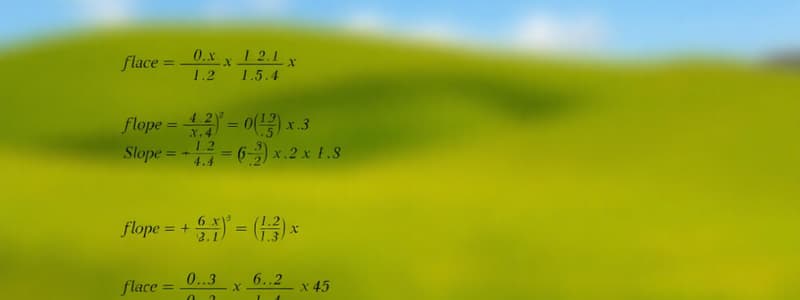Podcast
Questions and Answers
What effect does the transformation f(x + h) have on the graph?
What effect does the transformation f(x + h) have on the graph?
- Translates up
- Translates down
- Translates right
- Translates left (correct)
Which transformation occurs when using -f(x)?
Which transformation occurs when using -f(x)?
- Reflection over x-axis (correct)
- Vertical translation down
- Vertical translation up
- Reflection over y-axis
How does the slope of the function change during a dilation?
How does the slope of the function change during a dilation?
- It remains the same
- It becomes negative
- It changes depending on the stretch (correct)
- It always increases
What happens to the orientation of the graph when it is shrunk?
What happens to the orientation of the graph when it is shrunk?
Which of the following transformations translates the graph 3 units down?
Which of the following transformations translates the graph 3 units down?
What is the point-slope form of a line given point (-1, -1) and a slope of 1?
What is the point-slope form of a line given point (-1, -1) and a slope of 1?
Which of the following is a characteristic of parallel lines in relation to slope?
Which of the following is a characteristic of parallel lines in relation to slope?
In the slope-intercept form, what does the variable 'b' represent?
In the slope-intercept form, what does the variable 'b' represent?
What is the first step to convert a linear equation from standard form to slope-intercept form?
What is the first step to convert a linear equation from standard form to slope-intercept form?
What characteristic do parallel lines share?
What characteristic do parallel lines share?
What is the slope of a line defined by the equation y = 2x - 3?
What is the slope of a line defined by the equation y = 2x - 3?
What is true about the slopes of perpendicular lines?
What is true about the slopes of perpendicular lines?
Which equation represents a linear function where the slope is 1?
Which equation represents a linear function where the slope is 1?
What describes the intersection of perpendicular lines?
What describes the intersection of perpendicular lines?
What can be said about the y-intercepts of parallel lines?
What can be said about the y-intercepts of parallel lines?
What does a positive correlation indicate about the relationship between two variables?
What does a positive correlation indicate about the relationship between two variables?
Which range is indicative of a strong correlation in the R-Correlation Coefficient?
Which range is indicative of a strong correlation in the R-Correlation Coefficient?
What is an indication of a weak correlation between two variables?
What is an indication of a weak correlation between two variables?
If the correlation coefficient is 0, what can be inferred about the relationship between the two variables?
If the correlation coefficient is 0, what can be inferred about the relationship between the two variables?
What is the main characteristic of a strong correlation?
What is the main characteristic of a strong correlation?
What is the first step in graphing a linear inequality?
What is the first step in graphing a linear inequality?
When is a dashed line used to graph a linear inequality?
When is a dashed line used to graph a linear inequality?
What happens to the inequality sign when multiplying by a negative number?
What happens to the inequality sign when multiplying by a negative number?
Which direction do you shade when graphing the inequality $y < 2x + 3$?
Which direction do you shade when graphing the inequality $y < 2x + 3$?
What type of line represents the inequality $x
eq 5$?
What type of line represents the inequality $x eq 5$?
Flashcards
Horizontal Translation
Horizontal Translation
Shifting a graph left or right.
Vertical Translation
Vertical Translation
Shifting a graph up or down.
Dilation of a Graph
Dilation of a Graph
Stretching or compressing a graph.
Reflection over x-axis
Reflection over x-axis
Signup and view all the flashcards
Reflection over y-axis
Reflection over y-axis
Signup and view all the flashcards
Point-slope form equation
Point-slope form equation
Signup and view all the flashcards
Slope formula
Slope formula
Signup and view all the flashcards
Slope-intercept form
Slope-intercept form
Signup and view all the flashcards
Find parallel line
Find parallel line
Signup and view all the flashcards
Standard form
Standard form
Signup and view all the flashcards
Parallel Lines
Parallel Lines
Signup and view all the flashcards
Perpendicular Lines
Perpendicular Lines
Signup and view all the flashcards
Slope of Parallel Lines
Slope of Parallel Lines
Signup and view all the flashcards
Slope of Perpendicular Lines
Slope of Perpendicular Lines
Signup and view all the flashcards
Y-intercept of Parallel Lines
Y-intercept of Parallel Lines
Signup and view all the flashcards
Positive Correlation
Positive Correlation
Signup and view all the flashcards
Negative Correlation
Negative Correlation
Signup and view all the flashcards
Strong Correlation
Strong Correlation
Signup and view all the flashcards
Weak Correlation
Weak Correlation
Signup and view all the flashcards
R-Correlation Coefficient
R-Correlation Coefficient
Signup and view all the flashcards
Solid line
Solid line
Signup and view all the flashcards
Dashed line
Dashed line
Signup and view all the flashcards
Shading above/below
Shading above/below
Signup and view all the flashcards
Flip the inequality sign
Flip the inequality sign
Signup and view all the flashcards




